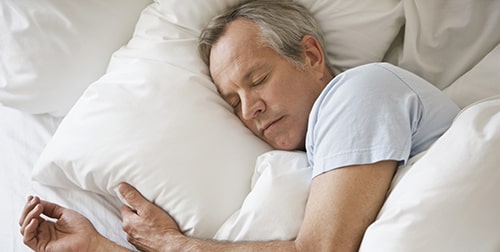According to the Global Burden of Disease study, lower back pain is the leading cause of disability in the world. The most interesting thing is that most complaints about back pain are not the result of some traumatic injury or a severe disease like cancer or even arthritis. Most lower back pain results from poor posture and awkward sleeping positions along with other lifestyle choices. So, sit up straight and consider some of the best sleeping positions to keep your back happy.
BREAKING: Newly Legalized Herb Relieves Pain - Available Without A Prescription
Side sleeping with a pillow
For restless sleepers, this might be a tough one, but sleeping on your side with a pillow between your knees helps relieve pressure on the lower back. The pillow helps to keep your hips, pelvis, and spine in better alignment. Here is how to properly side sleep:
- Roll over and allow your shoulder to make complete contact with the mattress as well as the entire side of your body.
- Place a semi-soft pillow between your knees.
- If you notice a space between your waist and your mattress, slide another pillow for support
Try to resist the urge to always sleep on the same side. This can lead to muscle imbalance.
Stomach sleeping with a pillow
Have you been avoiding your favorite sleeping position on your stomach because someone told you that it was bad for your back? The truth is, if done right, stomach sleeping is a great way to prevent back pain. However, if done wrong, it can put tremendous strain on your neck. If you have been diagnosed with degenerative disc disease, this sleeping position may be particularly helpful. Here’s how to properly stomach sleep:
- Place a semi-soft pillow under your pelvis and lower abdomen. This will help take some pressure off of your back.
- Try this position with and without a pillow under your head to see how it feels. Some people choose to sleep without a pillow under their head, while others prefer one.
Back sleeping with a pillow
Sleeping on your back helps to spread out your weight evenly and, thus, can take the pressure off of your back. In addition, back sleeping with a pillow helps keep your spine and internal organs better aligned. Here’s how to properly back sleep:
- Lay flat on your back.
- Place a semi soft pillow under your knees.
- For added support, place a rolled up towel under the small of your back.
Sleeping like a baby
Have you been diagnosed with a herniated disc? If so, sleeping like a baby may help reduce your pain and discomfort. The discs in your back provide a cushion between your vertebrae and spine. When part of the disc pushes out of its normal space, the result is herniation, pain, weakness, and more. In the fetal position, the space between the vertebrae is opened up, and pressure is reduced. Here’s how to properly sleep like a baby:
- Start on your back and gently roll over to one side.
- Tuck in your knees to your chest and curl your torso up towards your knees.
Switch sides to avoid developing muscle imbalances.
Sleeping reclined
For many people with back pain, some of their best nights of sleep have been in their favorite reclining chair. Sleeping in a reclined position can help to relieve pressure on your spine by creating a space between your thighs and torso. Here’s how to sleep reclined in bed:
- Purchase an adjustable bed and try different angles until you find the one that provides the most relief.
Caution: Don’t try to stack a bunch of pillows behind you to create a recline position. Pillows can shift in the night, and the angle of your head and body can cause more pressure and pain.
Always keep your alignment in mind
No matter what sleeping position you choose, always be thinking about alignment. This means that your ears, shoulders, and hips should be lined up. Use pillows to pad spaces that need additional support. Be very careful getting into and out of bed, as well as turning in bed. Tuck in your core and move your body as one unit each time you turn. This will help protect your spine.
Choosing the best pillow
You might not think that pillow type really matters, but it does. In fact, choosing the best pillow can not only help relieve back pain but can help usher in a great night’s sleep. Here are the best pillows for your favorite sleeping position. No matter what pillow you choose, be sure that it cradles your head and neck while supporting the upper portion of your spine.
Back sleepers – Consider a thinner pillow. Memory foam and water pillows work well for those who like to sleep on their backs.
Stomach sleepers – Stomach sleepers should try to get comfy first without a pillow. If you need a pillow, be sure that it isn’t too thick so that it raises your head and neck high.
Side sleepers – It is crucial for side sleepers to choose a firm pillow that will fill the space between your ear and shoulder. Make sure to place a pillow between your knees to help keep you appropriately aligned.
TRENDING: Diabetes Breakthrough Leaves Doctors Speechless - Try This Tonight
Note: You may have your favorite ancient pillow – you know that one you took to camp when you were 12. However, it is vital to change out your pillow every 18 months or so as they tend to hold a lot of allergens, including mites and mold.









